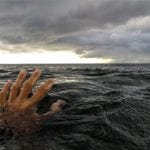 History
History  History
History  Animals
Animals Ten Times It Rained Animals (Yes, Animals)
 Mysteries
Mysteries 10 Devastating Missing Child Cases That Remain Unsolved
 Creepy
Creepy 10 Scary Tales from the Middle Ages That’ll Keep You up at Night
 Humans
Humans 10 One-of-a-kind People the World Said Goodbye to in July 2024
 Movies and TV
Movies and TV 10 Holiday Movies Released at Odd Times of the Year
 Politics
Politics 10 Countries Where Religion and Politics Are Inseparable
 Weird Stuff
Weird Stuff 10 Freaky Times When Famous Body Parts Were Stolen
 Miscellaneous
Miscellaneous 10 Interesting Things Manufacturers Stopped Making and Why
 Gaming
Gaming 10 Funny Tutorials in Games
 History
History 10 Desperate Last Stands That Ended in Victory
 Animals
Animals Ten Times It Rained Animals (Yes, Animals)
 Mysteries
Mysteries 10 Devastating Missing Child Cases That Remain Unsolved
Who's Behind Listverse?

Jamie Frater
Head Editor
Jamie founded Listverse due to an insatiable desire to share fascinating, obscure, and bizarre facts. He has been a guest speaker on numerous national radio and television stations and is a five time published author.
More About Us Creepy
Creepy 10 Scary Tales from the Middle Ages That’ll Keep You up at Night
 Humans
Humans 10 One-of-a-kind People the World Said Goodbye to in July 2024
 Movies and TV
Movies and TV 10 Holiday Movies Released at Odd Times of the Year
 Politics
Politics 10 Countries Where Religion and Politics Are Inseparable
 Weird Stuff
Weird Stuff 10 Freaky Times When Famous Body Parts Were Stolen
 Miscellaneous
Miscellaneous 10 Interesting Things Manufacturers Stopped Making and Why
 Gaming
Gaming 10 Funny Tutorials in Games
10 Creepy and Gruesome-Looking Sea Creatures
Everyone loves going to the beach, especially on a hot day. The ocean is a beautiful place almost anywhere in the world, with so many entertaining water activities you can enjoy. Whenever you think of the ocean, hopefully, good memories come to mind. Whether you go with your family or significant other, it’s always a good time.
The ocean also has some amazing sea creatures you can see, like whale watching or spotting dolphins alongside your boat. However, the waters of the deep blue sea also hold creepy and gruesome-looking animals. Where there is good, there is also bad. The ocean has a balance of some of the friendliest creatures. But it also has some of the scariest-looking species lying beneath its surface.
Related: Top 10 Fish That Hunt Land Animals
10 Sarcastic Fringehead
The sarcastic fringehead lives off the northeast coast of the Pacific Ocean and is often referred to as a tube benny. They mostly live in burrows or tube-like structures. Some have even been found to live in soda bottles. Most creatures are known to be territorial, and the sarcastic fringeheads are no different. The males are more likely to be the ones protecting their homes, so this is why females usually lay their eggs in the males’ burrows.
Females have even created this system where they make the male species more competitive and engage in territoriality. To establish dominance and protect its food sources, the male tube bennies will open their mouths wide. In comparison, their mouths are about four times as big when open. Both males will open their mouths and compare to see who has the biggest mouth. Whoever has the smallest mouth has to surrender and leave. Ah, so it’s even true in the fish world….
Though the sarcastic fringeheads have unusually wide mouths, they don’t have a history of eating big prey. Actually, they are known to eat planktonic prey like squid eggs. Because they live in burrows, they are rarely caught by fishermen. Luckily, staying very well hidden helps to limit their risk of extinction. So although they look scary, you don’t have to worry about them bothering you.[1]
9 Northern Stargazer
The real name of the northern stargazer is Astroscopus gottatus, but it is also known as the Popeye fish. Living primarily on the ocean floor, this is by far one of the strangest-looking fish. They have large heads with flat foreheads and spotted flat bodies. Their nostrils, eyes, gill slits, and most of their mouths are found on top of their heads. In addition to its odd looks, this fish also breathes through its nostrils rather than bringing water in through its mouth—a very unfishlike characteristic. The northern stargazer’s pectoral fins are helpful when burying themselves in the sand. These sea creatures can grow up to twenty-two inches in length and weigh up to 20 pounds.
They mostly feed on small fish and crustaceans. The northern stargazer will hide on the ocean floor with only their eyes and mouth sticking out. Then they will proceed to suck in their prey, using their large mouths. Remarkably, these creatures have an organ on top of their heads that creates an electric charge up to 50 volts. Because of this ability to electrocute other fish, they have been considered one of the meanest fish in the ocean. Oh, and they are also venomous![2]
8 Deep Sea Dragonfish
The deep sea dragonfish lives in deep waters at about 5,000 feet in depth. They are located mainly in the north and western Atlantic Ocean and the Gulf of Mexico. By far the most gruesome-looking fish with a long slender body. In addition, they have sharp fang-like teeth. Although the black dragonfish looks intimidating, they can only grow to be about six inches. Usually, the males are much smaller than the females. Because the deep sea dragonfish lives so deep in the water, not much is known about their mating habits.
To help survive in the ocean, this sea creature can produce its own light by a chemical process known as bioluminescence, which this fish utilizes amazingly—it can illuminate its whole body. The deep sea dragonfish uses its flashing light in the dark waters to attract prey or even potential mates. It survives on small fish and crustaceans or whatever else it can lure near its mouth. Its black-lined stomach helps disguise the prey as it’s digested since many of its meals also practice bioluminescence. So as long as you don’t follow those flashing lights in the deep sea, you’re pretty safe.[3]
7 Gulper Eel
The gulper eel is one unnatural-looking sea creature, mostly found in the tropical, temperate ocean. Known for its wide mouth, one of the gulper eel’s nicknames is “umbrella mouth.” Its mouth is larger than the eel’s entire body. It is loosely hinged and can open wide enough to swallow its prey whole. The prey is then kept into the lower jaw of the gulper eel’s mouth, which resembles something like a pelican’s mouth.
With its unusual features, the gulper eel is much different in appearance compared to other eels. This sea creature has small eyes that can only detect traces of light rather than form images. The tail is long in length and has a pink light at the end of it. The eel’s body is not primarily built for chasing prey, so it uses its “tail light” to lure crustaceans—its primary diet—close, allowing its huge mouth to snap up the prey. This abnormal-looking sea creature can also grow between three and six feet in length—though that’s mostly all tail. Still, not something you want to get near![4]
6 Fangtooth Fish
The fangtooth fish live well over 16,000 feet deep in the sea. Though they might migrate to the surface at night to catch their prey. This sea creature has a mouth filled with long, pointed teeth and is more active than most deep-sea creatures, actively searching for its prey. Their sharp teeth help ensure that the limited food source of the deep ocean finds itself in the fish’s mouth on the first strike.
It is one of the few deep ocean species that do not have a light-producing organ. Because of this, the fangtooth fish relies on its sense of smell. Thankfully, the fangtooth fish can only grow up to seven inches, making it relatively harmless to humans.[5]
5 Frilled Shark
The frilled shark looks like a prehistoric sea creature. It can grow up to seven feet in length with fins located far back on its body. This shark has rows of long teeth with three long points for snagging its prey—they prefer the soft-bodied squid. They are active predators and have been known to swallow their prey whole, regardless of its size.
The frilled shark has the same swimming traits as an eel in a serpentine motion. Humans will rarely encounter this sea creature as it lives in deep ocean water. It has been accidentally caught by bycatch in fisheries. Sometimes they are kept and eaten as food. Because of this, the frilled sharks are threatened with extinction.[6]
4 Angler Fish
There are more than 200 species of angler fish living in the deep depths—over 900 meters or 3,000 feet) of the Atlantic and Antarctic Oceans. Usually dark grey or brown in color, their heads are large, with enormous crescent-shaped mouths. In their mouths sit sharp, translucent teeth. As adults, some species can grow up to three feet in length.
The female angler fish holds one distinctive feature. It’s a piece of dorsal spine that protrudes above the mouth like a fishing pole. This feature baits the prey, which can be twice its size—an easy meal for the angler fish. Males are much smaller compared to females, growing to only about eight inches at maturity. An odd characteristic of male anglers is that they will latch onto females, remaining attached for life. During this process, they lose their eyes and internal organs—all except the testes. A female will carry six or more males on her body, allowing easy reproduction. Wow, most women can’t even handle one![7]
3 Giant Isopod
The giant isopod is one of the biggest crustaceans, closely related to shrimp and crabs. Amazingly, the giant isopod has existed for over 160 million years. They have seven pairs of legs with a hard exterior, possessing the ability to roll into a ball for protection like its relative, the land pillbug or “roly-poly.” The giant isopod resides on the deep ocean floor and is normally always in a state of semi-hibernation. They commonly limit their expenditure of energy for movement and breathing. Its overlarge size results from abyssal gigantism—a condition seen in animals living in deep ocean water. Think giant squid!
Because they are carnivores and scavengers, they feed on live and dead animals. But they can go a long period of time without eating. The longest recorded time was four years. Since food is scarce on the sea floor, they will eat in abundance when food is available.[8]
2 Goblin Shark
The goblin shark is one of the creepiest-looking sea creatures. It has a long prominent snout that’s covered with special sensing organs that help find electric fields in deep, dark water. The goblin shark has an unusual coloration to its body. It ranges from a pinkish color to a purplish grey color. A bright blue surrounds the edges of its fins.
Its jaw can protrude rapidly to help catch and devour its prey. This sea animal usually dines on fish, squid, and crustaceans. It has been recorded that the goblin shark’s jaws differ in length. At 16 feet when fully mature, it’s definitely not something you want t meet in the murky depths.[9]
1 Vampire Squid
The vampire squid is neither a squid nor an octopus, according to scientists. Granted, the sea creature has eights arms and two thin, long filaments, but the name comes from the dark color and the skin that connects the arms. It resembles a cape, much like one worn by a vampire. They live in dark waters deep in the ocean. When the vampire squid is frightened, it inverts its cape in a threatening show by putting its large spines on full display. These spines line the underside of its many arms.
The vampire squid feeds on plants and animal matter. Because they are relatively harmless, they depend on finding food particles rather than aggressive hunting. The sea creature uses a sticky cell on its tentacles to capture these bits of food. Unlike most octopuses or squids, the vampire squid does not squirt black ink. It will squirt out a substance that contains bioluminescent material to distract or confuse any predators. Like most deep-sea creatures, it can produce light at the tip of each of its arms, typically used for communication.[10]








